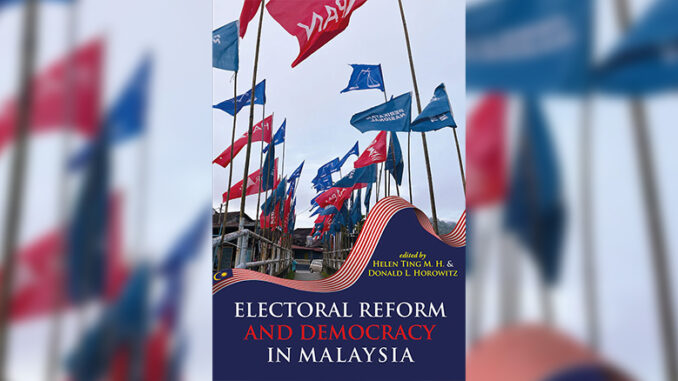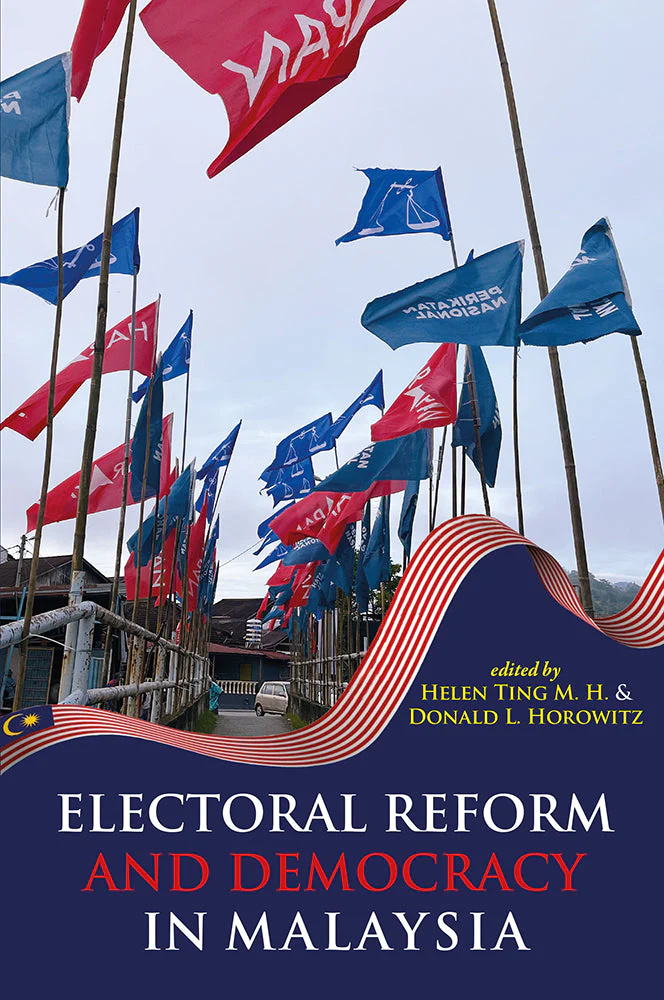
Title: Electoral Reform and Democracy in Malaysia
Authors: Helen Ting M. H. and Donald L. Horowitz (Eds.)
Publisher: NIAS Press, 2023
This edited volume of essays is a compelling study of Malaysia’s political evolution by renowned academic scholars who have meticulously explored the landscape of democratic reform in the country. Each chapter in the book provides a compelling in-depth analytical examination of the complexities of Malaysian politics by shedding light on the multifaceted factors that shaped the trajectory of the nation’s democratic process. The chapter contributors have comprehensively investigated various aspects of the seismic shifts that have transformed Malaysia’s political outcomes following Barisan Nasional’s historic electoral defeat in 2018 after decades of rule since the country’s independence in 1957 and provided critical insights on the implications of these changes on well-being of its political and democratic systems. The strength of this edited book volume lies in its exhaustive scrutiny of the aftermath of Barisan Nasional’s loss during the 14th general election in 2018 and the rise of the Pakatan Harapan government which is both timely and invaluable in understanding the repercussions of these groundbreaking developments that have had a profound impact on the country, especially during the 15th general election November 2022.
The book’s first part delves into the catalysts that have driven electoral reform in Malaysia while outlining the historical contexts and contemporary issues that have influenced its development. The chapter by Weiss provides a thought-provoking analysis of the reforms that came about when Pakatan Harapan gained power after the 14th general election in 2018 and the implications of the coalition’s collapse on the progress of these reforms. The chapter also identifies the factors that have hindered their development and discusses the challenges that the current unity government faces in continuing the reform agenda. Meanwhile, Khoo’s examination of Bersih and its contribution to electoral reformation in Malaysia provides an integral dimension to civil society movements’ role in driving the country’s democratic growth. In the chapter, she skilfully traces the crucial developments in electoral reform initiatives that culminated in the Bersih movement that successfully brought public awareness about voting in general elections which pressured the government to improve the process, and ultimately influenced the outcome of politics in Malaysia. The next chapter by Tay and Neo provides a comparative analysis of anti-hopping laws in parliamentary democracies of several Commonwealth countries that follow the Westminster tradition while exploring its impact on political stability. The authors’ in-depth examination of the legislative provisions contributes towards a greater understanding of the complex challenges caused by Members of Parliament who decide to cross the floor after being democratically elected. Faisal’s chapter on electoral administrative reform presents an informative overview of the Election Commission of Malaysia while outlining the background of its institutional structure and powers. In his research, he addresses the criticisms that have been levelled at the Election Commission and discusses administrative reforms that are needed to ensure efficiency and transparency in the electoral process, while emphasising the need for greater autonomy and enhanced capacity to “democratise” the institution. The last chapter of the first section by Ostwald investigates the politics of malapportionment and partisan bias in a dominant party regime which has contributed immensely to Barisan Nasional’s decades-long hegemonic grip on power. This deliberation unveils the complexities of the intricate relationship between electoral systems and dominant party politics, and how it can undermine electoral reforms in Malaysia. Ostwald’s analysis offers a captivating exploration of misaligned political representation and its implications for a new political equilibrium in Malaysia that is equitable and unencumbered by identity politics.

The second part of the edited book volume concentrates on the intricate interplay between ethnic dynamics and the electoral system by examining the dynamic challenges in the Malaysian political system due to its diverse ethnic population. Ting’s chapter extensively unpacks the intricate intersection between ethnic cleavages in Malaysia and the First-Past-the-Post Electoral System. In the discourse, she examines Barisan Nasional’s interethnic power sharing and cooperation during its initial beginnings, followed by the loss of the middle-ground voters and evolution from a Malay-dominated multiethnic coalition to a predominantly Malay one, which has implications on electoral reform. The chapter also reviews Pakatan Harapan’s efforts to build a multi-ethnic middle ground to stave off right-wing racial polarisation in the country. The following chapter by Horowitz provides an extensive examination of different electoral systems worldwide and discusses the Electoral Reform Committee’s reform proposal for proportional representation at the federal level, from the perspective of interethnic accommodation and vote-seat disparity. Saravanamuttu’s chapter also extends the discussion on reforming the first-past-the-post electoral system by reviewing the advantages and disadvantages of the proposals in the interim report, and the implications of the difficulties in pushing for reformative amendments. The next chapter by Reilly compares ethnic politics and electoral reform in Malaysia with other multi-ethnic democracies in Southeast Asia. As the only multi-ethnic country that does not have institutional structures for minority representation that rely on the first-past-the-post electoral system, Malaysian elections risk being manipulated by various actors for political gains. Although it is clear that reforms are necessary, ironically politicians who used to champion change while in the opposition have become less enthusiastic about following through with the reform agenda. Lastly, Dettman explores the idea of local government elections as a possible solution to the problem of ethnic politics in Malaysia. His scrutiny of the local council appointments during the Pakatan Harapan administration from 2018 to 2020 found that most of the urban councils in Malaysia correspond to the area’s demographics, but this mirrors the ethnic divisions in the country’s political system. Although theoretically, local government elections can encourage greater competence in administrative governance, Dettman believes that this is unlikely to occur, given Malaysia’s ethnoreligious identity politics.
In conclusion, these selected chapters anchor the volume and collectively contribute to an insightful narrative surrounding the issue of electoral reform of the democratic process in Malaysia. Each contributor highlights diverse aspects of the intricacies of Malaysia’s political environment and provides essential discourse and valuable perspectives about the challenges and possibilities in reshaping the country’s institutional and political structures. This edited book volume stands as an authoritative contribution to the field of knowledge and its intellectual framework is an invaluable resource for readers who seek enhanced comprehension of Malaysia’s dynamic evolution of electoral reform, making it an essential read for those seeking to understand the country’s complicated and evolving political system.
Reviewed by Pauline Pooi Yin Leong
Associate Professor, Department of Communication,
School of Arts, Sunway University
No. 5, Jalan Universiti, Bandar Sunway,
47500 Selangor Darul Ehsan, Malaysia.
